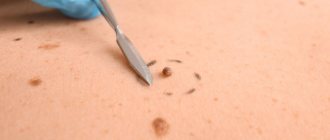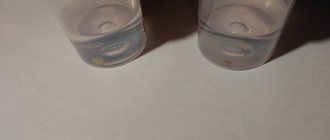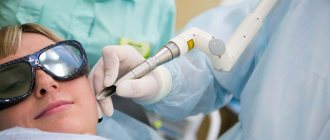A mole is a pigmented formation on the skin of a benign nature. The scientific name of a mole is nevus, it can be congenital or acquired, and its color varies from light brown, red, purple to black. Depending on their location, birthmarks can appear on any part of the skin of the body or mucous membranes. The largest number of acquired birthmarks is found in people over 50 years of age. In children, moles begin to appear in the first years of life; in newborns, they are practically absent.
Moles appear due to the accumulation of pigment cells that are located between the dermis (inner layer of skin) and epidermis (outermost layer of skin). Moles can be located inside the dermis, on the surface or in the border layers of the skin. It can protrude on the surface or be located inside. In size, moles can be very tiny, or grow to gigantic sizes - about 10-15 cm. The greatest danger in terms of cancer degeneration are moles of large or very large sizes. The danger of any mole is that, under certain conditions, it can become malignant or develop into skin cancer - melanoma.
Which moles are dangerous and require removal?
In most cases, small moles and medium-sized formations are not dangerous and require only dynamic monitoring by a specialist. But sometimes surgical removal of the tumor is necessary.
Mole removal is carried out in the following cases:
- when the shape and size of a mole changes;
- if the tumor is constantly injured (by clothing, linen, comb);
- a mole brings severe psychological discomfort due to its size or repulsive appearance, etc.
Several methods are used to remove tumors - conventional surgical excision, radiofrequency method, cryodestruction, but the safest and most effective method is laser removal of moles.
Myth #3. “Removing moles costs a lot of money”
Now on the Internet you can find a variety of prices for this service - from several hundred to tens of thousands of rubles. However, on average, the price for removing one mole in St. Petersburg with histology is about 3-5 thousand.
On the one hand, this is a really significant amount.
From another point of view, every month we leave significantly more money in stores and gas stations. However, you will have to buy food and gasoline for the rest of your life, and after professional removal, moles will no longer appear. You will no longer have to think about how to avoid touching them with clothes, how to protect them from the sun, and whether they have signs of cancer or melanoma.
Don't skimp on your health:
3-5 thousand is not small money. However, they allow you to solve the problem of moles forever, safely and beautifully.
Preparation for the procedure
Before laser removal, the tumor is examined. First, the doctor conducts a visual examination, and then examines the tumor under multiple magnification. Dermatoscopy is a safe, non-invasive and simple diagnostic method that allows detailed visualization of not only the superficial, but also the deep layers of the skin.
Using a laser, only benign neoplasms are removed, since the neoplasm is evaporated and subsequent tissue examination cannot be carried out. If there is the slightest suspicion of a malignant process, the laser cannot be used and removal is carried out surgically with excision of not only the mole, but also part of the healthy tissue.
Before interventions, it is necessary to undergo several tests - tests for blood group and Rh factor, coagulogram, etc.
No special preparation is required for the procedure. The patient arrives at the appointed time. The procedure takes from 5 to 10 minutes, depending on the size of the tumor. To remove moles, a laser knife or erbium laser is used, the operation is performed under local anesthesia.
What are the dangers of removing moles?
Many people ask the question: “Is mole removal dangerous?” This is really dangerous, which is why before the procedure the mole is carefully examined by an oncologist, who makes the main conclusion. This examination will show whether there is a possibility of the mole developing into a malignant tumor, and whether it is possible to do without removal. Moles that do not cause any discomfort and are located in familiar, inconspicuous places are still better not to remove.
Moles have indications for removal only when they begin to actively change, or when they are accidentally damaged. Moles that are in a somatic condition are removed only after permission from the oncologist.
Many people are concerned about another question: is removing moles harmful to the body? This procedure does not cause any side effects. Moreover, the place where the mole was removed will not pose any health hazard. If the procedure was performed by a specialist, then you don’t have to worry about relapse. It is for this reason that it is recommended to trust in this matter exclusively to specialists with many years of experience. Our clinic is ready to offer you the services of just such people.
How is laser mole removal performed?
Under the action of the laser, the neoplasm cells are heated and destroyed, and the laser also coagulates nearby blood vessels, so the risk of bleeding is negligible. During the treatment, the mole tissue and root are removed, which eliminates the risk of re-growth of the formation in this place. Depending on the size of the mole, removal is carried out over one or more procedures.
The operation is performed under local anesthesia, which eliminates pain. A small crust remains at the intervention site, which disappears on its own within 2 weeks. At this time, it is necessary to avoid moisture and friction at the site of manipulation, and also limit exposure to the sun; solarium, swimming pool, and bathhouse are also prohibited.
Myth #4. “Removing moles is terribly painful”
This myth goes back to the distant 80-90s, when moles in our country were removed only with a scalpel. Before the operation, the doctor used a regular thick needle to give 3-5 anesthetic injections along the skin incision. Then, during the operation, new injections were performed if the tissue dissection became painful or delayed.
Now things are much simpler. When removing moles using modern methods, injections are performed with the thinnest needles - no more than 0.12 mm thick. The newest combination drugs for local anesthesia act much stronger, faster and longer than their predecessors. In 99% of cases, one short injection with the introduction of a minimal amount of the drug is enough. In combination with psychological methods of pain reduction, all these measures can reduce discomfort to a minimum. When removing moles, a numbing cream may also be used .
A study in our clinic showed that only 8% of people after mole removal called this procedure painful.
Contraindication for laser treatment
- Oncological diseases, HIV, AIDS, viral hepatitis.
- Chronic diseases in the acute stage.
- Pregnancy and lactation period.
- Infectious and inflammatory diseases.
- Organ failure.
- Severe diseases of the cardiovascular system, diabetes.
- Mental illnesses.
In medical operations for laser removal of moles, they are carried out at a high professional level using modern laser technology of the latest generation, which eliminates the risk of complications or postoperative scars. The operation can be performed at any convenient time on an outpatient basis; after the intervention, you can go about your daily routine; it will not affect your usual lifestyle in any way. You can make an appointment by calling the center or leaving a request on the website.
Remove a mole on the face
Remove a mole on the face
Our body is covered with a huge number of moles. For the most part, they do not pose a danger, since they extremely rarely degenerate into malignant neoplasms. Nevertheless, such a risk exists. From this publication you will learn how to remove a mole on the face, and if any alarming symptoms appear, you should sign up for a consultation with a specialist.
Reasons for the formation of moles
Most moles form during the development of the body. During puberty, the main reason for the appearance of nevi is fluctuations in the level of hormones, including pituitary hormones, which regulate the production of melanin by skin cells. Hereditary predisposition plays a certain role in this process.
In adults, the formation of new moles can be provoked by various factors. One of the most significant is hormonal status. Changes in the hormonal profile are often accompanied by the appearance of neoplasms on the skin. This happens during pregnancy, or during long-term treatment of chronic diseases with the use of hormonal drugs.
New moles may appear on areas of the body that are exposed to intense ultraviolet radiation. Fans of artificial or natural tanning are at risk. Also at risk are workers who work outdoors in regions with a hot climate and a large number of sunny days a year.
The appearance of new moles in adulthood should be alarming, but, as a rule, there is no reason for serious concern. They are usually benign in nature. The reason for contacting a specialist may be the appearance of a large number of moles, as well as the formation of large skin formations for no apparent reason.
Dangerous and harmless
Medical statistics indicate that malignant degeneration of moles on the face is unlikely, but still possible. It is impossible to exclude an unfavorable scenario for the development of events; this is important to understand. In this regard, you should carefully examine skin formations and remain vigilant regarding alarming symptoms indicating a change in their nature.
In dermatology, it is customary to identify five main signs that indicate the possible degeneration of a mole on the face, or on another part of the body, into a tumor. They are denoted by the acronym ACORD: Asymmetry, Edge, Color, Size and Dynamics. The average person should remain alert to more symptoms so as not to miss the alarm bell.
You should contact a specialist if at least one of the following symptoms appears:
- The size of the mole changed and it began to grow.
- The new mole is asymmetrical.
- The color of the tumor has changed.
- The nevus begins to hurt. A burning sensation, itching, or other physical discomfort appears.
- The nature of the surface has changed: instead of smooth, it has become loose and uneven.
- The edge of the tumor has changed: clear contours have become jagged.
- The density of the nevus has changed: it has become harder or, on the contrary, softer.
- Bleeding from the skin formation occurs periodically.
- The skin around the nevus shows signs of inflammation: redness, swelling, peeling.
Experts recommend removing a mole on the face if at least one of the alarming symptoms appears.
Large nevi (diameter more than 10 cm), as well as formations located in places where there is a high probability of mechanical damage, are subject to removal. For example, a mole on the neck can be injured by jewelry. Make an appointment
What happens after a mole is removed
Every day in our country hundreds, and maybe thousands of skin lesions are removed using different methods. Unfortunately, healing is not always perfect. Today I will talk about the possible cosmetic consequences of removing moles and warts. Read this article to the end and you will learn how to avoid problems after such operations ( tips are marked in italics
).
Normal healing after removal
Normally, on the second or third day after removal of a mole, a dark, dry crust remains at the site of the operation. The same thing happens when you get scratched or cut. The size of the crust is usually the same as the removed formation or 1 mm larger. Gradually it peels off from the skin and, after about 2 weeks, disappears completely. At the site of removal, a small reddish pit remains, no more than 1-2 mm deep. At the end of the fourth week, the bottom of the fossa rises to the level of the surrounding skin. By the end of the third month, in most cases, the redness disappears and a barely noticeable mark remains on the skin from the removed mole.
BEFORE removal 3 months AFTER
The picture below shows the healing process as a diagram:
normal healing after removal is called a normotrophic scar
Hypertrophic scar (bulge)
A hypertrophic scar is a hard, red lump raised above normal skin around the surgical site. It may hurt or itch, but these symptoms always go away with time. When, a few weeks after the removal of a mole or wart, something similar appears in its place
Such a scar is in no way associated with the development of melanoma and skin cancer after mole removal
.
any person will start to worry. Fortunately, a hypertrophic scar does not pose any danger other than a cosmetic defect. Sometimes, after a few months, it itself becomes flatter, softer and takes on the color of normal skin. In some particularly difficult cases, its correction is required, which I will write about in more detail a little later.
If you notice the development of such a scar, please do not worry - it is not forever and doctors are quite successful in dealing with it. There is only one case where it is better for you to see the doctor who performed the removal - if the mole was removed without histology. To reduce the likelihood of scar formation, strictly follow your doctor’s recommendations and consult him again if you notice the first signs - redness and thickening. Try not to wet the removal site until a crust appears and never peel it off.
Hypotrophic scar (depression)
Another, quite common, situation is when a mole was removed, and a small hole has formed in this place. This condition is called a hypotrophic scar and means that the skin cells have not worked enough to restore its surface. Unlike a hypertrophic scar, this healing option is not so obvious; as a rule, it does not cause concern, does not require correction and gradually smoothes out after 1-2 years
.
White spot (hypopigmentation)
This condition occurs in two cases. In the first case - if within 3-4 months from the operation you have been sunbathing for a long time. In the second case, if the mole or wart was located in the deep layers of the skin, and the cells that form the pigment were completely removed and were not restored. This condition is not dangerous to health and can go away on its own without your intervention. To prevent hypopigmentation from developing, try to protect the surgical site from the sun for 3-4 months. If you still couldn’t avoid the appearance of a white spot, remember, it will go away on its own in 1-2 years.
BEFORE removal 3 months AFTER
Suppuration
Sometimes, if the rules of surgery are not followed or the wound is not properly cared for, inflammation and subsequent suppuration may develop at the site where the mole or wart was removed. This unpleasant condition has 4 main symptoms: pus, redness, swelling and tenderness. We can talk about suppuration only when all 4 symptoms are present AT THE SAME TIME.
You should not think that suppuration has occurred when there is only redness around or slight swelling of the wound. If a clear or yellowish liquid sometimes comes out from under the crust, there is also no cause for concern. This is due to the fact that only a viscous white liquid - pus - is one of the main signs of suppuration.
To avoid this unpleasant complication after removing a mole, strictly follow the recommendations of the doctor who removed the wart or mole. Particular attention should be paid to treating the wound with an antiseptic.
Reappearance of a mole after removal (recurrence of pigmented nevus)
If the mole is not completely removed and nevus cells remain in the skin, a relapse may occur. In this case, at the site of removal, after the crust falls off or a little later, a dark spot appears, no more than 1-3 mm in size, not protruding above the skin. According to the few studies on this issue, recurrence of a pigmented nevus does not lead to the development of melanoma and skin cancer, if the histology shows a pigmented nevus. This condition requires nothing more than observation. If desired, the relapse can be removed again.
IMPORTANT!!!
Did you have a mole removed without histology, without dermatoscopy or even without an examination by an oncologist?
Is there a spot at the removal site? I strongly recommend excision of it again with a scalpel with mandatory histological examination. In such a situation, melanoma cannot be ruled out! I cannot help but note that, in my experience, the reappearance of a mole is possible even if its complete removal is confirmed by histological examination. This question is still awaiting its researchers.
Summary, or briefly about the main thing:
The cosmetic result of mole removal only partially depends on the surgical technique and the doctor’s qualifications. Otherwise, all of the above options for skin restoration depend on the individual characteristics of your body. Modern science, unfortunately, is not able to accurately predict in advance which of them and to what extent will affect the regeneration of your skin. You can see the cosmetic results of mole removal
Injection of an anesthetic drug under the skin
Any local anesthetic drug causes an unpleasant tingling or burning sensation when it enters the skin through the needle. This is due to the fact that the drug pushes the tissues apart and has an irritating effect on them. In this case, a characteristic “button” forms on the skin.
In order to smooth out this moment, we use the most modern drugs for local anesthesia. They provide excellent pain relief using a minimal amount of substance. The smaller volume pushes the tissues apart less, the injection time is shorter, and the pain is less.
What can be the consequences of removing moles and why?
So, practice shows that the removal of moles has negative consequences only if the procedure was carried out without the use of laser equipment. That is, using freezing with liquid nitrogen, as well as using electrocoagulation. These are painful procedures that leave scars. Surgical removal of a mole is currently performed extremely rarely, as it is an outdated option.
You can also look at photos of the consequences of mole removal to make sure that only the laser does not leave any traces. In the first couple of months, a small depression may remain, but after a while it completely disappears. The procedure for laser mole removal in Moscow is carried out by specialists from the LazerJazz clinic using modern equipment. It should be noted that removal of condylomas , for example, requires a special approach, which is determined by their location. In our work, we use careful technologies for removing such tumors.
When is it necessary to remove a birthmark?
In some cases, surgical removal of moles is indicated:
- if the birthmark is constantly exposed to mechanical stress (for example, due to friction with underwear, clothes);
- when a mole causes psychological discomfort to the wearer (for example, it is on the face);
- if the nevus is in a precancerous state.
Constant mechanical impact and trauma to the birthmark is extremely undesirable, because this increases the risk of its degeneration into melanoma. If the mole is located on an area of the skin where belts, straps and fasteners of underwear and other fairly rigid elements of clothing are supposed to be worn, then most often dermatologists advise removing it.











